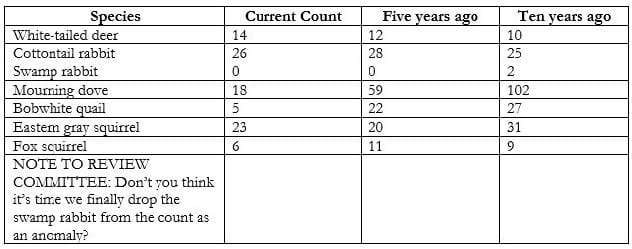Exam Details
Exam Code
:77-725Exam Name
:Word 2016 Core Document Creation, Collaboration and CommunicationCertification
:Microsoft CertificationsVendor
:MicrosoftTotal Questions
:35 Q&AsLast Updated
:Mar 29, 2025
Microsoft Microsoft Certifications 77-725 Questions & Answers
-
Question 31:
SIMULATION Project 1 of 7: Observation Overview You are a member of the Barstow College Observation Project committee. You are preparing the initial
summary report for this year's count, but have not received all of the data you need to complete the report.

Introduction
The multi-departmental Wildlife Observation Project has completed its wildlife population counts for this
year. The counts were made between May 5 and May 7 for both the wilderness and cultivated land areas.
This is in line with the count periods for all previous years. The species used for the counts have been
identified as common for the region (central Missouri) in which the counts were taken. (Author, 2009) As in
previous years, five observation blinds were set up two weeks before the counts were to take place.
Counters worked eight-hour shifts providing 24-hour coverage of the count areas for two days. Weather for
both observation days was clear and mild (varying between 50-70 degrees F).
The results presented here are summary total results only, which counts from five and ten years ago
provided for comparison. Detailed observation results will be available as soon as they are completed. We
estimate that they will be available some time in the next two weeks.
Wilderness Summary
The wilderness observation area is a five-acre section of unimproved forest land. The most common trees
in the area are maple, red oak, cedar, sweet gum, and hickory. The area also includes a small spring. The
area is not enclosed by a fence or other man-made barrier.
The area is located eight miles from the nearest paved road and twelve miles from the nearest residence.
Off-road vehicles were used to bring counters close to, but not entering, the count area. The nearest
approach by off-road vehicles was one mile.
The table below lists the summary counts.

Though further research any analysis is needed, the drop in mourning dove and bobwhite quail counts
could be significant. The detailed count data shows these numbers failing off each year.
Cultivated Land Summary
The cultivated land observation area is a five-acre section of cultivated land near the center of a 50-acre
field. The field is used to grow corn, wheat, soybeans, and clover, with the crop rotated annually. In the fifth
year of the cycle, the field is left fallow.
The area is located two miles from the nearest paved road and one mile from the nearest residence. A
storage barn is located at the southern border of the field.
The table below lists the summary counts.
Additional Notes
This project was initially scheduled to run for ten years, so we are currently in our last year. The committee
needs to decide if it is worth the time and expense to continue the project. The landowners have
experience that they would be happy to let us continue. Costs relating to the project is minimal and it does
provide an opportunity to offer extra credit to students volunteering as counters. A suggestion has been
made by some committee members that we should increase the count frequency, counting on a quarterly
schedule instead of an annual schedule. This would need to be coordinated with the owner of the
cultivated field so that we do not interfere with planting or harvesting schedules.
Special Thanks
Once again, we would like to offer special thanks to:
We couldn't do this without you.
Add a Status of "Requires committee review" to the document properties.
A.
-
Question 32:
SIMULATION Project 1 of 7: Observation Overview You are a member of the Barstow College Observation Project committee. You are preparing the initial
summary report for this year's count, but have not received all of the data you need to complete the report.

Introduction
The multi-departmental Wildlife Observation Project has completed its wildlife population counts for this
year. The counts were made between May 5 and May 7 for both the wilderness and cultivated land areas.
This is in line with the count periods for all previous years. The species used for the counts have been
identified as common for the region (central Missouri) in which the counts were taken. (Author, 2009) As in
previous years, five observation blinds were set up two weeks before the counts were to take place.
Counters worked eight-hour shifts providing 24-hour coverage of the count areas for two days. Weather for
both observation days was clear and mild (varying between 50-70 degrees F).
The results presented here are summary total results only, which counts from five and ten years ago
provided for comparison. Detailed observation results will be available as soon as they are completed. We
estimate that they will be available some time in the next two weeks.
Wilderness Summary
The wilderness observation area is a five-acre section of unimproved forest land. The most common trees
in the area are maple, red oak, cedar, sweet gum, and hickory. The area also includes a small spring. The
area is not enclosed by a fence or other man-made barrier.
The area is located eight miles from the nearest paved road and twelve miles from the nearest residence.
Off-road vehicles were used to bring counters close to, but not entering, the count area. The nearest
approach by off-road vehicles was one mile.
The table below lists the summary counts.

Though further research any analysis is needed, the drop in mourning dove and bobwhite quail counts
could be significant. The detailed count data shows these numbers failing off each year.
Cultivated Land Summary
The cultivated land observation area is a five-acre section of cultivated land near the center of a 50-acre
field. The field is used to grow corn, wheat, soybeans, and clover, with the crop rotated annually. In the fifth
year of the cycle, the field is left fallow.
The area is located two miles from the nearest paved road and one mile from the nearest residence. A
storage barn is located at the southern border of the field.
The table below lists the summary counts.
Additional Notes
This project was initially scheduled to run for ten years, so we are currently in our last year. The committee
needs to decide if it is worth the time and expense to continue the project. The landowners have
experience that they would be happy to let us continue. Costs relating to the project is minimal and it does
provide an opportunity to offer extra credit to students volunteering as counters. A suggestion has been
made by some committee members that we should increase the count frequency, counting on a quarterly
schedule instead of an annual schedule. This would need to be coordinated with the owner of the
cultivated field so that we do not interfere with planting or harvesting schedules.
Special Thanks
Once again, we would like to offer special thanks to:
We couldn't do this without you.
In the table below the "Wilderness Summary", adjust the column width so that all columns are the same
width.
A.
-
Question 33:
SIMULATION Project 1 of 7: Observation Overview You are a member of the Barstow College Observation Project committee. You are preparing the initial
summary report for this year's count, but have not received all of the data you need to complete the report.

Introduction
The multi-departmental Wildlife Observation Project has completed its wildlife population counts for this
year. The counts were made between May 5 and May 7 for both the wilderness and cultivated land areas.
This is in line with the count periods for all previous years. The species used for the counts have been
identified as common for the region (central Missouri) in which the counts were taken. (Author, 2009) As in
previous years, five observation blinds were set up two weeks before the counts were to take place.
Counters worked eight-hour shifts providing 24-hour coverage of the count areas for two days. Weather for
both observation days was clear and mild (varying between 50-70 degrees F).
The results presented here are summary total results only, which counts from five and ten years ago
provided for comparison. Detailed observation results will be available as soon as they are completed. We
estimate that they will be available some time in the next two weeks.
Wilderness Summary
The wilderness observation area is a five-acre section of unimproved forest land. The most common trees
in the area are maple, red oak, cedar, sweet gum, and hickory. The area also includes a small spring. The
area is not enclosed by a fence or other man-made barrier.
The area is located eight miles from the nearest paved road and twelve miles from the nearest residence.
Off-road vehicles were used to bring counters close to, but not entering, the count area. The nearest
approach by off-road vehicles was one mile.
The table below lists the summary counts.

Though further research any analysis is needed, the drop in mourning dove and bobwhite quail counts
could be significant. The detailed count data shows these numbers failing off each year.
Cultivated Land Summary
The cultivated land observation area is a five-acre section of cultivated land near the center of a 50-acre
field. The field is used to grow corn, wheat, soybeans, and clover, with the crop rotated annually. In the fifth
year of the cycle, the field is left fallow.
The area is located two miles from the nearest paved road and one mile from the nearest residence. A
storage barn is located at the southern border of the field.
The table below lists the summary counts.
Additional Notes
This project was initially scheduled to run for ten years, so we are currently in our last year. The committee
needs to decide if it is worth the time and expense to continue the project. The landowners have
experience that they would be happy to let us continue. Costs relating to the project is minimal and it does
provide an opportunity to offer extra credit to students volunteering as counters. A suggestion has been
made by some committee members that we should increase the count frequency, counting on a quarterly
schedule instead of an annual schedule. This would need to be coordinated with the owner of the
cultivated field so that we do not interfere with planting or harvesting schedules.
Special Thanks
Once again, we would like to offer special thanks to:
We couldn't do this without you.
Merge all cells in the bottom row of the table below the "Wilderness Summary" heading into one cell.
A.
-
Question 34:
SIMULATION Project 1 of 7: Observation Overview You are a member of the Barstow College Observation Project committee. You are preparing the initial
summary report for this year's count, but have not received all of the data you need to complete the report.

Introduction
The multi-departmental Wildlife Observation Project has completed its wildlife population counts for this
year. The counts were made between May 5 and May 7 for both the wilderness and cultivated land areas.
This is in line with the count periods for all previous years. The species used for the counts have been
identified as common for the region (central Missouri) in which the counts were taken. (Author, 2009) As in
previous years, five observation blinds were set up two weeks before the counts were to take place.
Counters worked eight-hour shifts providing 24-hour coverage of the count areas for two days. Weather for
both observation days was clear and mild (varying between 50-70 degrees F).
The results presented here are summary total results only, which counts from five and ten years ago
provided for comparison. Detailed observation results will be available as soon as they are completed. We
estimate that they will be available some time in the next two weeks.
Wilderness Summary
The wilderness observation area is a five-acre section of unimproved forest land. The most common trees
in the area are maple, red oak, cedar, sweet gum, and hickory. The area also includes a small spring. The
area is not enclosed by a fence or other man-made barrier.
The area is located eight miles from the nearest paved road and twelve miles from the nearest residence.
Off-road vehicles were used to bring counters close to, but not entering, the count area. The nearest
approach by off-road vehicles was one mile.
The table below lists the summary counts.

Though further research any analysis is needed, the drop in mourning dove and bobwhite quail counts
could be significant. The detailed count data shows these numbers failing off each year.
Cultivated Land Summary
The cultivated land observation area is a five-acre section of cultivated land near the center of a 50-acre
field. The field is used to grow corn, wheat, soybeans, and clover, with the crop rotated annually. In the fifth
year of the cycle, the field is left fallow.
The area is located two miles from the nearest paved road and one mile from the nearest residence. A
storage barn is located at the southern border of the field.
The table below lists the summary counts.
Additional Notes
This project was initially scheduled to run for ten years, so we are currently in our last year. The committee
needs to decide if it is worth the time and expense to continue the project. The landowners have
experience that they would be happy to let us continue. Costs relating to the project is minimal and it does
provide an opportunity to offer extra credit to students volunteering as counters. A suggestion has been
made by some committee members that we should increase the count frequency, counting on a quarterly
schedule instead of an annual schedule. This would need to be coordinated with the owner of the
cultivated field so that we do not interfere with planting or harvesting schedules.
Special Thanks
Once again, we would like to offer special thanks to:
We couldn't do this without you.
Add a table with eight rows and four columns in the "Cultivated Land Summary" section, below the text
"The table below lists the summary counts."
A.
-
Question 35:
SIMULATION Project 1 of 7: Observation Overview You are a member of the Barstow College Observation Project committee. You are preparing the initial
summary report for this year's count, but have not received all of the data you need to complete the report.

Introduction
The multi-departmental Wildlife Observation Project has completed its wildlife population counts for this
year. The counts were made between May 5 and May 7 for both the wilderness and cultivated land areas.
This is in line with the count periods for all previous years. The species used for the counts have been
identified as common for the region (central Missouri) in which the counts were taken. (Author, 2009) As in
previous years, five observation blinds were set up two weeks before the counts were to take place.
Counters worked eight-hour shifts providing 24-hour coverage of the count areas for two days. Weather for
both observation days was clear and mild (varying between 50-70 degrees F).
The results presented here are summary total results only, which counts from five and ten years ago
provided for comparison. Detailed observation results will be available as soon as they are completed. We
estimate that they will be available some time in the next two weeks.
Wilderness Summary
The wilderness observation area is a five-acre section of unimproved forest land. The most common trees
in the area are maple, red oak, cedar, sweet gum, and hickory. The area also includes a small spring. The
area is not enclosed by a fence or other man-made barrier.
The area is located eight miles from the nearest paved road and twelve miles from the nearest residence.
Off-road vehicles were used to bring counters close to, but not entering, the count area. The nearest
approach by off-road vehicles was one mile.
The table below lists the summary counts.

Though further research any analysis is needed, the drop in mourning dove and bobwhite quail counts
could be significant. The detailed count data shows these numbers failing off each year.
Cultivated Land Summary
The cultivated land observation area is a five-acre section of cultivated land near the center of a 50-acre
field. The field is used to grow corn, wheat, soybeans, and clover, with the crop rotated annually. In the fifth
year of the cycle, the field is left fallow.
The area is located two miles from the nearest paved road and one mile from the nearest residence. A
storage barn is located at the southern border of the field.
The table below lists the summary counts.
Additional Notes
This project was initially scheduled to run for ten years, so we are currently in our last year. The committee
needs to decide if it is worth the time and expense to continue the project. The landowners have
experience that they would be happy to let us continue. Costs relating to the project is minimal and it does
provide an opportunity to offer extra credit to students volunteering as counters. A suggestion has been
made by some committee members that we should increase the count frequency, counting on a quarterly
schedule instead of an annual schedule. This would need to be coordinated with the owner of the
cultivated field so that we do not interfere with planting or harvesting schedules.
Special Thanks
Once again, we would like to offer special thanks to:
We couldn't do this without you.
Add a SmartArt Vertical Bullet List below the text "Once again, we would like to offer special thanks to: ".
Add the text "Frank Miller" to the top green shape.
A.
Related Exams:
62-193
Technology Literacy for Educators70-243
Administering and Deploying System Center 2012 Configuration Manager70-355
Universal Windows Platform – App Data, Services, and Coding Patterns77-420
Excel 201377-427
Excel 2013 Expert Part One77-725
Word 2016 Core Document Creation, Collaboration and Communication77-726
Word 2016 Expert Creating Documents for Effective Communication77-727
Excel 2016 Core Data Analysis, Manipulation, and Presentation77-728
Excel 2016 Expert: Interpreting Data for Insights77-731
Outlook 2016 Core Communication, Collaboration and Email Skills
Tips on How to Prepare for the Exams
Nowadays, the certification exams become more and more important and required by more and more enterprises when applying for a job. But how to prepare for the exam effectively? How to prepare for the exam in a short time with less efforts? How to get a ideal result and how to find the most reliable resources? Here on Vcedump.com, you will find all the answers. Vcedump.com provide not only Microsoft exam questions, answers and explanations but also complete assistance on your exam preparation and certification application. If you are confused on your 77-725 exam preparations and Microsoft certification application, do not hesitate to visit our Vcedump.com to find your solutions here.